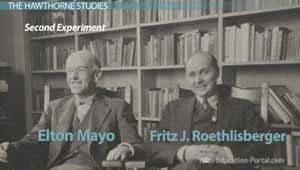The Hawthorne Effect: The Study of Employee Productivity - Quiz
Choose your answer and write the correct one down. Then click HERE for the answers to this quiz.
NOTE: The transcript from the video is listed below the quiz for your reference.
1. Which of these terms describes a psychological phenomenon in which participants in behavioral studies change their behavior or performance in response to being observed?
- The Hawthorne effect
- The Hawthorne consequence
- The observation effect
- The Hawthorne observation
- The Mayo effect
2. The Hawthorne effect was first witnessed in which of these events?
- The Hawthorne football game at Hawthorne University
- The Hawthorne workers' strike at Western Electric Company's Hawthorne Works
- The Hawthorne studies at Western Electric Company's Hawthorne Works
- The Hawthorne union assembly in Hawthorne, Illinois
- The Hawthorne wedding ceremony in Hawthorne, Illinois
3. Which two researchers are most commonly associated with the Hawthorne studies?
- Mayo and Hawthorne
- Roethlisberger and Hawthorne
- Mayo and Roethlisberger
- Taylor and Mayo
- Roethlisberger and Taylor
4. What was studied in the first Hawthorne study?
- Lighting levels and worker productivity
- Lighting levels and worker satisfaction
- Lighting levels and worker motivation
- Lighting levels and worker eye sight
- Lighting levels and worker fatigue
5. According to the Hawthorne effect, which of these describes what happens to employee productivity when they are being watched or observed closely?
- Productivity decreases
- Productivity increases
- Productivity remains the same
- Productivity is ignored
- Productivity is rewarded
Does your behavior change when you think people are watching? This lesson describes the purpose and findings of the Hawthorne studies and their contribution to the practice of management.
Social Context of Work Environments
Meet Tom. He is a young college graduate who was hired at Trekkie Technology about six months ago. Tom is miserable at Trekkie because he cannot stand the people that he works with. Jim is a pompous jerk, Mary is a constant complainer, Sarah spends more time gossiping than working and Tom's boss, Bill, is never around when Tom needs him. Instead of focusing on his job, Tom spends much of his workday distracted, trying to keep his emotions in check so that he does not tell his coworkers what he really thinks of them. Needless to say, Tom avoids these people at all costs, which is relatively easy due to his coworkers' preoccupations with themselves and others keeping them away from their desks.
Meet Jenny. She was in Tom's graduating class but is employed at The Force Technology, a direct competitor of Trekkie Technology. Unlike Tom, Jenny loves her job, especially because of the people she works with. Jenny has always found The Force to be a great place to work because her coworkers and manager are supportive and work together to help each other succeed. Jenny's manager, Irene, considers herself a part of the team and even shares the same workspace as her subordinates. Jenny is able to focus on her work and ask questions when needed and is highly productive as a result.
What makes Tom and Jenny so different? They both graduated from the same school. They both work for technology companies. However, what is clearly different is the social context in which they perform their work. Tom works in a distracting, negative work environment, whereas Jenny works in a supportive and inspiring work environment. Productivity is directly affected by these work environments. For Tom, productivity is diminished, but for Jenny productivity increases.
The Hawthorne Effect
The correlation between the social context of a workplace environment and employee productivity can best be understood by examining the Hawthorne effect.
 |
The Hawthorne effect is a psychological phenomenon in which participants in behavioral studies change their behavior or performance in response to being observed by the individual conducting the study. In the workplace, the Hawthorne effect can explain how the more attention an employee receives from managers, coworkers and customers, the higher the level of effort and employee productivity. Essentially, productivity increases when employees think that they are being watched or observed closely.
 |
If we go back to our example of Tom, his manager was never around when Tom needed him, and his coworkers were more interested in themselves or gathering the latest gossip on others. This allowed for Tom's productivity to decline. However, Jenny's work environment was much different in that she worked closely with her coworkers and manager, a factor that Jenny felt increased her level of productivity. Because Jenny worked collaboratively with her coworkers and manager, she felt a sense of teamwork and common purpose.
The Hawthorne Studies
The term 'Hawthorne effect' was derived from the location where the phenomenon was first witnessed during a series of experiments: Hawthorne, Illinois. What are commonly known as 'the Hawthorne experiments' consisted of two studies conducted at the Western Electric Company's Hawthorne Works, just outside of Chicago, from 1924 to 1932. The Hawthorne studies were designed to find ways to increase worker productivity.
 |
Up until this point, the focus of increasing productivity in workers was based on Frederick Taylor's work in finding the best possible way to perform a task and using financial rewards as incentives to increase employee motivation. The Hawthorne experiments were along those same lines.
The first experiment, conducted by a group of engineers, looked at what effects lighting levels had on employee performance at Western Electric. The results of the study showed that even as lighting levels decreased, employee performance continued to increase - that is, until the workers could no longer see, after which productivity naturally declined.
 |
The second experiment was conducted a few years later by Elton Mayo and Fritz J. Roethlisberger, who supervised a group of five women in a bank writing room. As part of the experiment, the women were given special privileges such as periodic breaks from work, free lunches and pay increase incentives. This study also resulted in increased employee performance. Mayo and Roethlisberger did not attribute the increased performance to the special privileges; rather, they concluded that the increased levels of productivity were a result of the supervisory arrangement. That is, because the experiment placed the observers in close proximity to the five women being observed, the interest in the workers on the part of the observers is what increased the five women's motivation to modify performance. The five women wanted to be seen as high performers by the observers.
The Hawthorne Studies' Legacy
The conclusion from the Hawthorne studies illustrates the importance of considering the social and human relations needs of workers. Mayo and Roethlisberger's conclusions about productivity increasing when management and coworkers made employees feel valued by showing them additional attention was in sharp contrast to the common perceptions of that time.
 |
Suddenly, financial rewards were found to be much less conducive to worker motivation and productivity. The Hawthorne studies paved the way for behavioral management theory and have significantly shaped the manner in which employee motivation is accounted for in the workplace. For Tom and Jenny, these same social aspects are what directly affected their levels of productivity and overall job satisfaction. Indeed, the legacy of the Hawthorne studies lives on as we continue to regard social and human relations as crucial aspects of business management.
Lesson Summary
Let's review. The Hawthorne effect is a psychological phenomenon in which participants in behavioral studies change their behavior or performance in response to being observed by the individual conducting the study. In the workplace, the Hawthorne effect can explain how the more attention an employee receives from managers, coworkers and customers, the higher the level of effort and employee productivity. Essentially, productivity increases when employees think that they are being watched or observed closely.
The term 'Hawthorne effect' was derived from the location where the phenomenon was first witnessed during a series of experiments designed to find ways to increase worker productivity. The Hawthorne experiments consisted of two studies: one on lighting levels at Western Electric Company's Hawthorne Works and the other on offering special privileges to five bank workers. What was not blatantly obvious at the time soon became a staple of behavioral management theory. That is, it is important to consider the social and human relations needs of workers. Such needs have a direct effect on employee performance and levels of productivity.